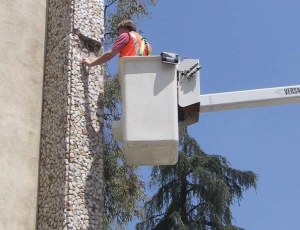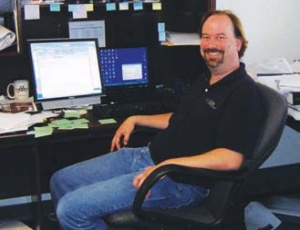It�s Thursday afternoon. The coffee needs warming; documents, drawings and text books are piled around the office; sticky notes surround the computer; and Gary R. Searer is at his desk studying five unique projects.


�This is a typical day for me,� says Searer, a structural engineer at the Burbank branch of Wiss, Janey, Elstner Associates, Inc. �I don�t just have one big project that I am working on. I am constantly juggling,trying to get one report out the door and start a new project at the same time.�
Searer, who joined WJE 15 years ago,also serves as the branch unit manager and associate principal. The Northbrook, Ill.-based company, which specializes in the structural engineering of existing buildings and structures, has in recent years worked on buildings affected by Sept. 11 in New York, the Interstate 35W Bridge collapse in Minnesota and the Interstate 5 tunnel fire in California.
Searer says being a structural engineer is exciting and interesting because of the wide variety of projects and interesting challenges.
�The challenges posed by the projects I work on require creativity to solve the problems and diligence to figure out why something happens,� he says. �I have lots of textbooks, but in general the projects we work on aren�t covered in full in textbooks. We can get some information from books or PHD research papers, but it�s the art and science of being an engineer and putting it all together.�
He says a typical day at the office begins with a stream of e-mails to check. They could include a note from the corporate counsel or librarian, a reminder to fill out staff performance forms, a deadline from a co-worker about a technical paper that�s being written, or an inquiry from someone asking Searer to do fieldwork.
He says that after checking e-mails, he can focus on current projects, which may include meetings with members of his 11-person staff , going into the field for project inspection or going over various code specifications.
On this particular Thursday Searer is working on the structural repair of an industrial tilt-up building in which an explosion killed two people and damaged the entire roof framing.
�This is a job where I got the call late Friday night and they said they needed somebody out there Saturday morning,� Searer says. �The first thing was to go there and fi gure out how to stabilize [the structure] so Cal/OSHA could come in and perform its investigation. I drew up sketches showing where I wanted emergency shoring and then they had a contractor come in.�
Another project on Searer�s desk is the Golden Nugget tower in Las Vegas. On this assignment, he and a couple members of his crew fl ew to Vegas to consult on water proofing design.
Then there is the ongoing historical renovation of the Antelope Valley Indian Museum, a state project that began in 2006 and is now frozen because of California�s budget crisis. In this case, WJE was hired to insulate and reinforce the two-story building, which was haphazardly designed and built by a Hollywood set designer in the 1920s.
The other two projects in front of him involve a reservoir with leaky joints and a mass transit system. Both are under investigation and litigation, so Searer says he could not discuss them.
He adds that projects involving litigation amount to about 10% of his workload.
�We are hired by insurance companies, attorneys or an owner to give our opinion,�he says.


Post a comment to this article
Report Abusive Comment